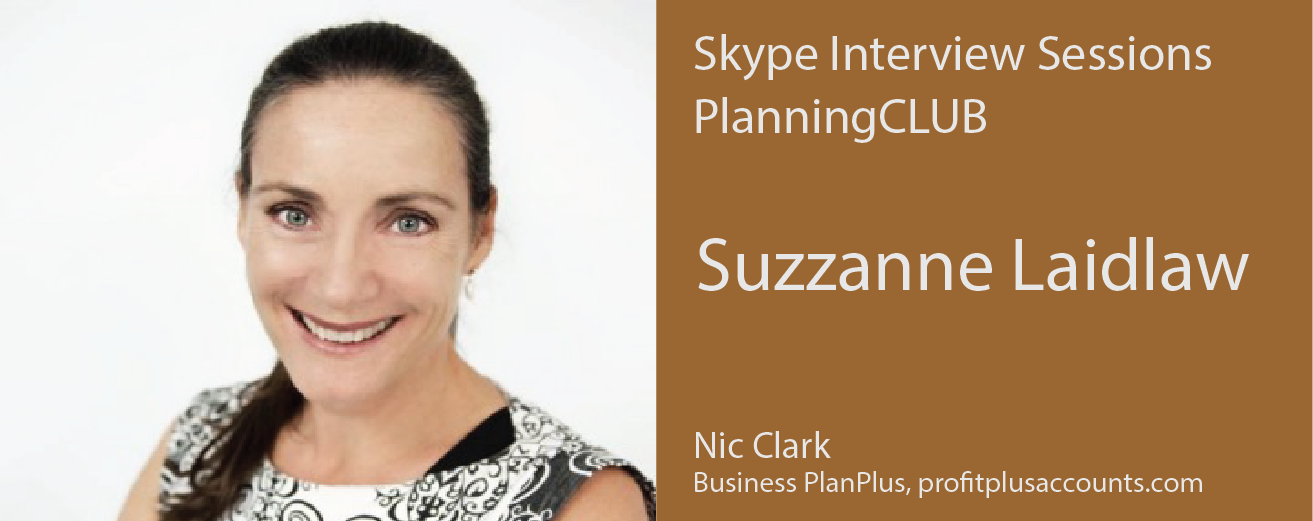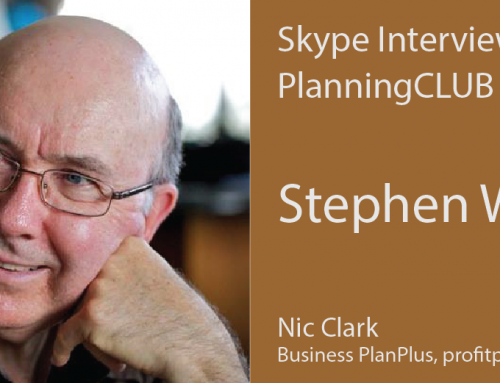Business Plans & Financial Modelling
An interview with Suzzanne Laidlaw on Creating A Business Plan using the ProfitPlus Accounts PlanningSYSTEM. She has been doing a group business planning workshop using the ProfitPlus Accounts online systems with her small business clients to great success. The interview covers how she uses the system, the client results and how other franchisees can use the system. Suzzanne accesses the ProfitPlus Accounts system via a license agreement between ActionCOACH and ProfitPlus Accounts.
She just keeps telling everyone about how amazing it was because her awareness of what was possible in her business was just heightened so much that she has this renewed, invigorating enthusiasm for her business.
Business Plans & Financial Modelling
Nic Clark:
How many clients have you put through the Creating A Business Plan group now? It’s more than 12, isn’t it?
Suzzanne Laidlaw:
Yeah, something like that. Yeah, I can’t remember about that.
Nic Clark:
You’ve gone through – now, you’ve seen two totally different systems. You saw version 1?
Suzzanne Laidlaw:
Yeah.
Nic Clark:
And now you’ve seen version 2. And you probably actually seen about three quarters of the way through version 2?
Suzzanne Laidlaw:
Yes.
Nic Clark:
So a few releases in. So what’s been your discovery of the two different online business planning versions?
Suzzanne Laidlaw:
Yeah, I think just thinking about it, it seems to be like a bit more versatile, which is better. I think it just seems to be a bit more versatile so far because of any done day one.
And a bit, I think it seems to be a little bit faster as well, a bit more user-friendly. I really like the way – I love the magnifying glass. I think that’s great. I think that’s a really good feature because people can actually see what their business plan looks like.
And I like the examples in the business plan system.
The creating a business plan using the ProfitPlus Accounts Planning System system has great examples, like talking about the mission and things like this, where you can have examples of what other people have said because sometimes, it’s really hard for people to think about it. So that’s pretty cool.
I just think it’s good the way they can do five years out in your business plan as well. Whereas the other one is only three years out, which is I think a better feature. I haven’t gone through it yet because its in day two but there seems to be more actual charts than the other one.
Nic Clark:
Yes, there’s a lot more since version 1, we’ve added in:
- Break even
- Monthly cash flow
- Financial ratios
- Online printing
And I believe we’ve added in the ratios into the online business planning as well. So you’ve probably got at least three charts that we’ve added into the system.
Suzzanne Laidlaw:
Yeah. So I was going through it the other day. I’m sitting here, talking to myself, “Oh, I like that. Oh, I love that.” It’s good. Preparing going through it, which was a nice an pleasant surprise, which is all the better for them.
The other thing that I found was I liked the What If, which the other one doesn’t have, the What If scenario so that they have the short cuts to their key reports says they change things, which I think I’ll use on next Friday, or this Friday coming up, which will be good.
And I also like the way you’ve got three different areas to go to where you want to go to. So you can click along or you can go down to the short cut on the right hand side, all the What Ifs.
Some brains, a lot of brains work a little bit different. So it’s good that they can actually – whichever way works best for their brain, to get to where they want to actually go which is useful.
So, yeah. So they were the main – after one day, they were the main things that I found different and better.
Nic Clark:
You’ve worked with a few clients now doing it.
Suzzanne Laidlaw:
Yes.
Nic Clark:
It’s 12 or more than that. And between you and Paul, there are quite a few. So what have you noticed as the take-away for a client? There’s a bit of work to be done. So what’s there gain out of all of this?
Suzzanne Laidlaw:
We have alerted them to things that they actually just didn’t know existed.
Main thing is that people don’t know what they don’t know. That seems to be my biggest, the biggest fear as far as this.
There are so many business owners out there that have done our course, that have done the workshop. But we have alerted them to things that they actually just didn’t know existed.
I don’t know how many people have said USP. What’s a USP? Unique Selling Point. No one has ever asked them why they’re unique. No one has ever asked them that. So to me, the biggest benefit is the actual awareness, the raising awareness of the people in the room. What they do with the actual report afterwards, to me, is a very – probably 10% of the benefit. The benefit is all in the room.
How Many people have said, “CRM? What’s a CRM?” And then you explain to them what it is. And they say, “My god, there is such a thing. Wow, that’s amazing. And it gives you reminders when to ring people. I always wondered why the chiropractor knew my birthday. I always wondered why they – wow, that’s amazing.” There’s people that live in this bubble that don’t know all these things that exist.
“And having KPIs, what are they? Oh wow, you just drill it down to their key performance. My god.” You know these guys. Rex I don’t know if you saw Rex testimonial. He’s like, “Oh, this is bloody brilliant, all this bloody information. It’s amazing.” These real base blocks that have only ever worked with trading’s or have only ever done their trade.
And you talked to Rex about it and he will just rave on, “Oh, it’s bloody amazing.” Because he’s in his late 60s. He’s just been in is own area. He’s never had traders are not exposed to business chart concepts.
And the similarly – and I think you might have seen her testimony. I think I screened shot it and sent it to you, the lady who’s been running. She runs about 50 to 60 blocks. She’s been running her business for 20 years. It totally blew her mind because there was just so much awareness that she – her heightened awareness of what was available in her business to her.
Telling everyone about how amazing it was because her awareness of what was possible in her business was just heightened!
She just had no idea and she just keeps telling everyone about how amazing it was because her awareness of what was possible in her business was just heightened so much that she has this renewed, invigorating enthusiasm for her business that she hadn’t had for years, which is amazing because she’s just so excited about her business now, because she just got stale and got sick of same old, same old. And her partner is retiring. So she’ll be taking it over and she’s got this renewed vigour.
Nic Clark:
During the Creating A Business Plan session … how do your clients go with the numbers? Because I know with sometimes – because I was doing the processing of the version 1, I know numbers was generally not a strong suit of a lot of clients. But how do you go with the numbers with them? Is it a BFO for them? Or is it just a struggle or what is it?
Suzzanne Laidlaw:
There are quite a few elements to that. The first element is the inputting of the information. Now, I had one guy on Friday that he even though we’d sent out to bring his last up-to-date end of financial year profit loss, he didn’t.
And he said, “Oh no, I missed the start and all that crap. I don’t have anything to do with that.” And I said, “Well, we need to get that information in.” He said, “Well, that’s fine. I’ll just get her to do it. I’m not even going to try and look at that.”
So that was fine. I just moved him on to the next section to work on, and then I just spoke to him about an hour ago, and he said, “She’s already put it in. So I’ll go ahead and check what she’s done.” So that was fine.
There was a couple that did have it, but they weren’t quite sure because there were certain areas that had been expanded in there profit and loss. So it took two seconds to say, “Oh, no. Just add that income together and that’s the total income for the year. Stock, purchases, all that is the same as the cost of a good sub. Great, okay.”
It took me two minutes to go through and then just highlight the key numbers to put in and then to put them in.
… And I said, “Look. Of course, you can get your accountant to check it afterwards anyway.”
So for the most illiterate people there were, as illiterate as possible, it still wasn’t difficult to pick out the 10 numbers and say put them in. And that was it. As long as that total is the same as the total on the bottom of that, that’s fine. And as long as that the main numbers like your gross profit, your net profit, your costs are good, you fixed expenses – as long as they’re all matching up, that’s fine. So that was cool.
The other element which comes in, in day two and I think you get quite a few BFOs there is the financial projections. That’s where I think – well, the other two times I’ve done the workshop, that’s where a lot of BFOs come. Because then they get to see the, “Wow. If I move this, this is what’s going to happen and this this.”
the gap between her being successful and unsuccessful, for the next financial year was so small.
The lady that I was telling you about that had lots of BFOs that has been in business for 20 years, once she done her projections, she thought her business was like way behind the eight ball. Once we’ve done the numbers, the gap between her being successful and unsuccessful, for the next financial year was so small. It only worked out to be just only a little bit extra that would make a huge difference.
Just knowing that has given her a huge awakening, It was like, “Wow, I’ve only got to go out and get that. And I’ve got a whole year to get it.” Because all the rest were already existing clients and it was existing contracts. And she was worried about maybe making a loss. And then she realized how small it was, she had to actually increase to get a reasonable profit.
Nic Clark:
With all the guys out in the field who maybe haven’t given this a go yet or somewhere in between, any kind of points of advice you’d like to impart from your hill of wisdom of doing a few?
Suzzanne Laidlaw:
It’s about being a good facilitator. It’s about being a good coach, but a good group coach because you’re basically facilitating to get all their intellectual property out of their head.
I think that the most benefit that I’ve had is to get the most amount of talking. It’s about being a good facilitator. It’s about being a good coach, but a good group coach because you’re basically facilitating to get all their intellectual property out of their head and in the right context, with whatever we’re going through in that business plan at the time, so that everyone’s information can be shared.
And I think the more you can get that you’re comfortable with together, the more benefit for everybody else, but you’re like a conductor. You’ve got to orchestrate it because you kind of have some people talking too much, some people dominating. You’ve got to keep it on the time because you want to get day one finished. By the end of the day, you want to get to your morning breaks, lunch breaks finished.
Yes. So that since I’ve done, I think. How many have we done now? I think maybe five of them. That seems to be the most benefit they get. Is the information from all the sharing from other people!
And then, I’ve also had cross-sharing where they’re going through strategies and things like? They say oh have you found that one? What are you doing? Have you done that?” Which is great.
I found, as far as the lunch break goes, I’ve changed that and I just take them to the pub because I got a pub next door. So I just take them to the pub and I don’t have to worry about the food. That’s done. I just they take it beforehand and that’s done. If they get out of the room, it is good. So I don’t have to organize catering or anything like that.
The more comfortable I can get and the more conversation I can get going, the better benefit for them. I just have to keep the timing right so that I finish it at the end time. So I’m trying to get people out of the room by 4:00. That seems to be pretty easy to get them out at 4:00. So, depending on if they’re really fast or really slow as far as inputting data, or more people or less people. The less people I can get more conversation going that’s of value.
The more people I have to really keep on at because when we’ve got eight people in the room doing business planning, I’ve got to be really tight with moving right along, make the conversation go quickly. “Let’s move it along.” Whereas if there are less people, you can let it flow with a bit more chitty chat. So it just depends on the numbers purely. That’s it.
Nic Clark:
So your goals with regards to the numbers in the room, you’ve worked out that if you can put four businesses into the room and Paul can put four businesses into the room, then it’s pretty – that’s a good number for you two guys. Is that how you’ve worked it? Are you splitting the days? Are you doing one day and he does one day?
Suzzanne Laidlaw:
Yeah, we do one day each, my goal is five and I didn’t quite get my goal. I only got four which was annoying. But I got five nevertheless and if we do one day each, then it’s only one day out of our business.
There are other coaches that want to work with another coach. It’s a great idea. Just pick a coach that you trust. And Paul and I trust each other to never poach each other’s clients and always support each other’s clients. So we’ve both done it with our clients in the room not just potential clients prospects.
And if there are questions that come up in relation to coaching, we will say, “Listen. Talk to Paul.” Or he’ll say, “Talk to Suzzanne. She’s your coach. She will discuss that with you afterwards.” And that way, it’s good because we both trust each other.
Nic Clark:
Any parting words of wisdom because you’ve given us a lot. So thanks for that.
Suzzanne Laidlaw:
Yeah. I would probably say my biggest failure with this would have to be my marketing engine. I’m not very strong as far as the marketing side of things go.
I think if you had a strong marketing engine or a strong database or a longer time to build up, I think that’s important because you really want to get the number of businesses.
Planning club is great and you want to get a good amount. So if you’ve been a coach for say 10 years and you’ve got a string of past diags, every one of them could easily be contacted. And with your hand on your heart, say, “Well, do you have a business plan?” You never took on coaching but the first thing when you’re going to build a house is to get a plan. So you are going along running your business. “Do you have a plan? Yes or no?” If they say no and they haven’t got one yet, do you think it’s better with or without a plan?
And then, it’s something that’s an easy purchase. It’s not expensive.
Coaches are charging, ranging from a few thousand. Whatever they’re charging is not going to be too much for a business owner. And they could put on the credit card, pay it off over a few payments. Anyone can afford it. It’s just going to give them so much value that they’ll get the money back tenfold.
So going back to all them, if you got your database because that’s where we went first, current clients and database. And we got 12, 15 or something in the room with the first one to do their business plan.
Nic Clark:
Okay. That’s a pretty good number.
Suzzanne Laidlaw:
Yeah. Well, that was between the two of us.
Nic Clark:
Yeah. It’s still a pretty good number.
Suzzanne Laidlaw:
Yeah.
Nic Clark:
When you say, it was a good leverage for you, what did you mean by that?
Suzzanne Laidlaw: :
Because it means that if I’m going to spend one day doing a business plan workshop for four business owners, I might as well be doing it for six or eight business owners.
Now, some people might not have the luxury of having a boardroom with WiFi like I do. I could probably fit in a big boardroom. I’ve got a couple of board rooms too choose from, I can probably fit 20 business owners.
I would recommend if you’re a lone ranger coach, go and see an accounting firm. I’m part of an accounting firm; I lease my office from an accounting firm. They have all got big boardrooms. If you tell them, you’ll give it to their clients. At a discounted rate if I can have your boardroom for nothing.
He thought it was wonderful so that he can do it for his clients.
I’m sure my accountant did it. He did it. He thought it was wonderful so that he can do it for his clients. So the boardroom, big round table is so great. They bring their own laptop. It’s a really, really great environment for them. You don’t have to pay for any of the conference rooms that have PCs that’s quite expensive.
I don’t pay anything for my boardroom. I don’t pay anything for the WiFi.
They bring their own laptops, and it works fine. The speed is fine. Yeah, it’s a win-win situation.
I do have three Internets for back up. I’ve got the accounting firms one, my own one that I use. And I have a five way Dongle just in case anything ever slows up. We always swap over if the Internet starts getting ‘Fridayitus’ its as sometimes, I’ll say, “Okay. Try the other one. Log off and try the other one.” So there’s something to say so that you’re not stuck. And that sometimes works.
But yeah, don’t use the excuse of, “I don’t have any way to hold them.” Just go and find your local accounting firm and work with them on how it can help their clients to get a great business plan together.
Nic Clark:
Thanks for your input on creating a business plan using the ProfitPlus Accounts Planning System and thanks very much for talking about business planning and your PlanningCLUBs … there’s going to be some coaches out there that will think this is wonderful.
Suzzanne Laidlaw:
Okay. Well, I hope it helps.
Nic Clark:
Yeah, it does.
Suzzanne Laidlaw:
and thank you for all your help Nic.
your only two seconds away and you’ve never not helped me if I ever had my 101,000 questions!
So the questions are getting slow. I’m giving you less questions now.
Nic Clark:
Thank you and if you need me…
Suzzanne Laidlaw:
I will see you at the conference.




